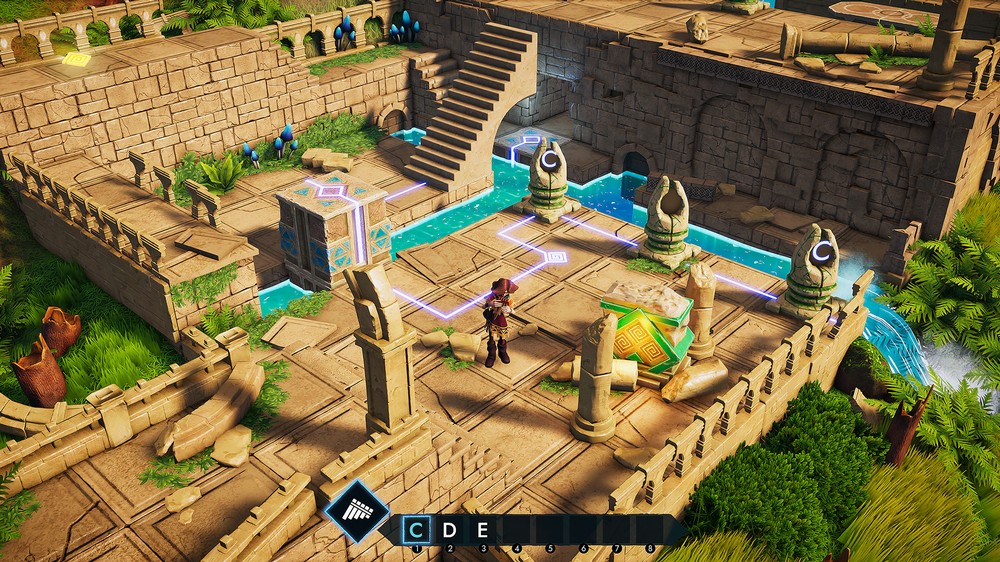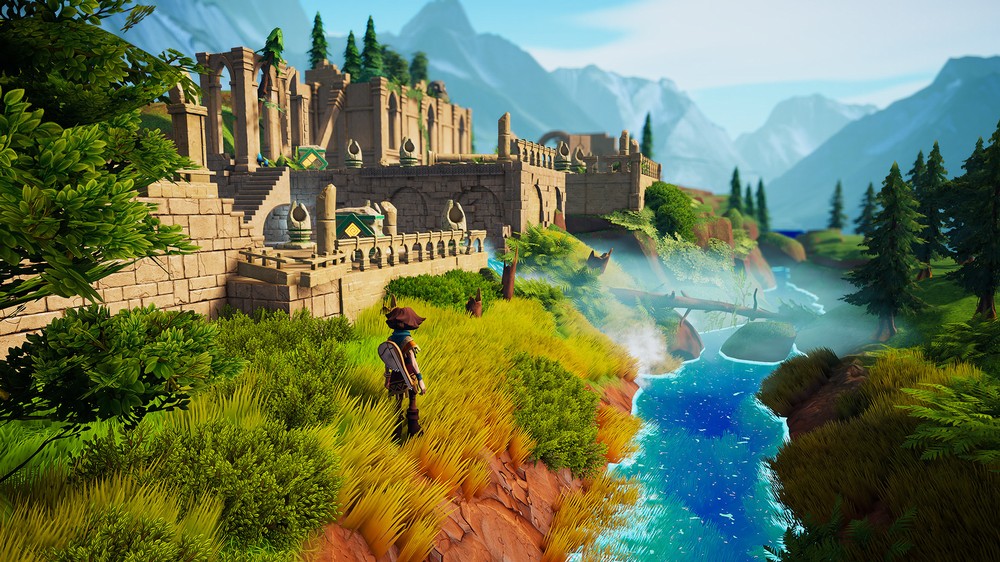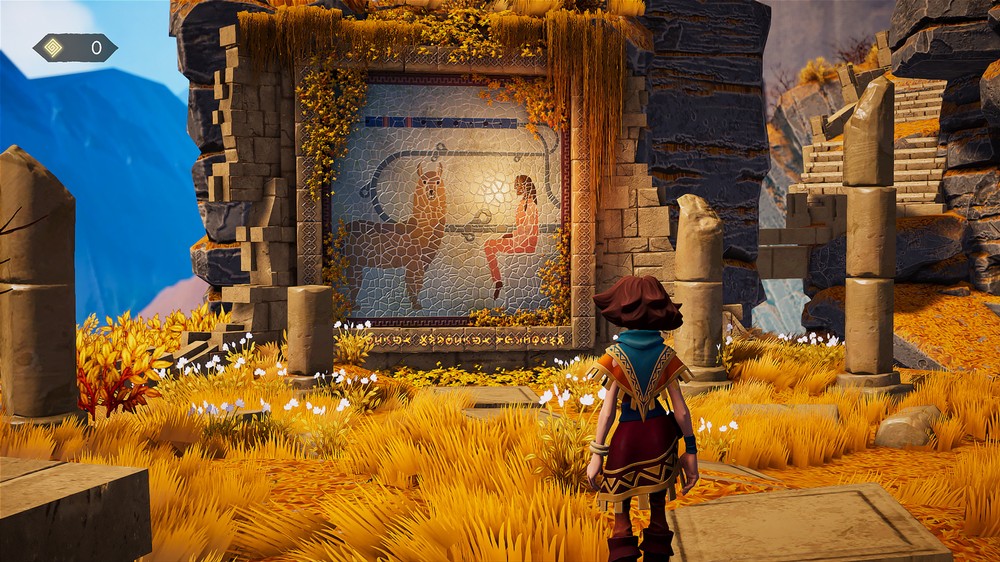Puzzle games come and go; some are memorable, and others easily forgotten while others are so unique, they manage to rise above the genre and stake their claim to greatness. Sonority is just such a game with a stunning visual design, interesting gameplay mechanics, and enough variety to keep you engaged for the 6-8 hour runtime; although your time may vary based on a player’s puzzle-solving skills, musical ability, and the ability to actually understand the rules of this world.
 Sonority does offer a story and as is common with these types of games, you don’t really need one, but I appreciate the effort. You’ll play as Esther who sets off to help a friend with only her pan flute. Along the way you’ll meet singing stone heads and a chatty raccoon who will serve as your taskmaster once you reach the hub area and setup a makeshift base. You’ll need to traverse all sorts of environmental puzzle situations using the power of music to affect the world around you.
Sonority does offer a story and as is common with these types of games, you don’t really need one, but I appreciate the effort. You’ll play as Esther who sets off to help a friend with only her pan flute. Along the way you’ll meet singing stone heads and a chatty raccoon who will serve as your taskmaster once you reach the hub area and setup a makeshift base. You’ll need to traverse all sorts of environmental puzzle situations using the power of music to affect the world around you.
The game claims you don’t need a musical background to play, which is true, but having some sort of a musical base will certainly make the experience more enjoyable. You’ll get to play several instruments throughout the adventure; some puzzles actually require complex mixtures of notes from different instruments. I’ll try to explain the gameplay, but this image likely does a better job.
The world is constructed of moving blocks, which form towers, ledges, floors, and even bridges. All of these objects are linked to these statues that act as note receptacles. It’s up to you to figure out how all the moveable blocks need to be arranged so you can exit the scene, and it’s all done through music.
First, you need to be playing the correct instrument; you’ll be told when you aren’t, and then you must figure out the proper notes to insert into each statue, so when played in their linear sequence, the world will shift around you to create your exit pathway. While solving these puzzles doesn’t require you to know the difference between a C and a G note you do need to understand the “intervals” between notes. Thankfully, the note chart for each instrument is displayed at the bottom for easy reference, so if you need to raise a block two “spaces” or rotate some steps 90-degrees you need to play the proper notes to make it happen. Notes that are lower than the previous will lower items or rotate them counterclockwise while ascending notes will raise environmental objects or spin them clockwise in 45-degree steps. Yeah…it’s mind-boggling and brilliant at the same time, and once the concept clicks you are going to love it.
 The gameplay in Sonority is constantly evolving throughout the game, as new musical notes and even new instruments are added to your arsenal. Likewise, the puzzle situations also grow increasingly more challenging with more notes in a steam or even multiple note streams that must be triggered at certain times so the two paths work together. While these musical interludes are the core of Sonority, there is still plenty of exploration and discovery including gold collectibles scattered about. You’ll even encounter certain musical composition areas where notes are already programmed and a song is already playing, but there are multiple empty sockets and empty statues just waiting for a note to be assigned and placed into the note stream, allowing you to compose short snippets of original music for playback within the game world.
The gameplay in Sonority is constantly evolving throughout the game, as new musical notes and even new instruments are added to your arsenal. Likewise, the puzzle situations also grow increasingly more challenging with more notes in a steam or even multiple note streams that must be triggered at certain times so the two paths work together. While these musical interludes are the core of Sonority, there is still plenty of exploration and discovery including gold collectibles scattered about. You’ll even encounter certain musical composition areas where notes are already programmed and a song is already playing, but there are multiple empty sockets and empty statues just waiting for a note to be assigned and placed into the note stream, allowing you to compose short snippets of original music for playback within the game world.
 There are a few downsides to Sonority. The contact awareness for Esther and the note statues is hit and miss, which means you’ll need to rub all over these statues until they light up in recognition. While you can choose to play the game using real musical notes, numbers, or symbols, the real trick is learning the controller inputs for those notes, which are in fact changing with each new instrument. So just about the time you memorize the button layout for the pan flute you get a new instrument and all the notes are remapped. This could all be easily fixed with having your controller buttons displayed under the notes rather than just 1-8. It’s not game-breaking, but it does turn a lot of the later puzzles into these trial and error attempts where you try to remember what button does which note.
There are a few downsides to Sonority. The contact awareness for Esther and the note statues is hit and miss, which means you’ll need to rub all over these statues until they light up in recognition. While you can choose to play the game using real musical notes, numbers, or symbols, the real trick is learning the controller inputs for those notes, which are in fact changing with each new instrument. So just about the time you memorize the button layout for the pan flute you get a new instrument and all the notes are remapped. This could all be easily fixed with having your controller buttons displayed under the notes rather than just 1-8. It’s not game-breaking, but it does turn a lot of the later puzzles into these trial and error attempts where you try to remember what button does which note.
 Puzzles get really challenging later on when you need to work around certain rules or conditions. Some note streams may already have statues with static notes in place, so you will need to arrange your composition to work around those existing notes. There are also paired note statues, so putting a B note into one statue replicates across all matching statues. Considering how simple the premise is, I was amazed at the level of challenge this concept added to the experience. The game is dismissively easy for the first hour when you only have a few notes, but later on when you have all eight notes and all available instruments things get crazy-complicated with trial-and-error solutions that can take several minutes to figure out, and the satisfaction for solving these puzzles has never been more deserved.
Puzzles get really challenging later on when you need to work around certain rules or conditions. Some note streams may already have statues with static notes in place, so you will need to arrange your composition to work around those existing notes. There are also paired note statues, so putting a B note into one statue replicates across all matching statues. Considering how simple the premise is, I was amazed at the level of challenge this concept added to the experience. The game is dismissively easy for the first hour when you only have a few notes, but later on when you have all eight notes and all available instruments things get crazy-complicated with trial-and-error solutions that can take several minutes to figure out, and the satisfaction for solving these puzzles has never been more deserved.
 Along with the gorgeous graphics is a fantastic audio presentation that is mostly soothing background tunes, although you will have chances to harmonize with the environment, playing along with chanting stone heads or opening chests with musical combination locks. You can even hear your most recent puzzle solution riffs getting embedded into the background score. It’s all pretty awesome…magical even! Best of all, the game is not terribly demanding, so it should be playable on just about any PC that still turns on. My RTX3080 was easily able to present this at full 4K with all sliders maxed out.
Along with the gorgeous graphics is a fantastic audio presentation that is mostly soothing background tunes, although you will have chances to harmonize with the environment, playing along with chanting stone heads or opening chests with musical combination locks. You can even hear your most recent puzzle solution riffs getting embedded into the background score. It’s all pretty awesome…magical even! Best of all, the game is not terribly demanding, so it should be playable on just about any PC that still turns on. My RTX3080 was easily able to present this at full 4K with all sliders maxed out.
 Sonority is the sleeper hit of the summer and at only $20 more than worth the ticket price. Arguably, the gameplay is a bit linear but the way they designed around a central hub means you can explore as you see fit, within the confines of your current notes and instruments. If you get stuck you probably shouldn’t be there. There are also plenty of guides and walkthroughs out there if you do get hung up on a particular musical puzzle. It’s rather ironic that a puzzle that could take 10-15 minutes to figure out can be solved/spoiled with a single screenshot showing the proper notes, but that doesn’t always take into account any special timing for triggering the note streams or even going back and changing some notes for different desired effects.
Sonority is the sleeper hit of the summer and at only $20 more than worth the ticket price. Arguably, the gameplay is a bit linear but the way they designed around a central hub means you can explore as you see fit, within the confines of your current notes and instruments. If you get stuck you probably shouldn’t be there. There are also plenty of guides and walkthroughs out there if you do get hung up on a particular musical puzzle. It’s rather ironic that a puzzle that could take 10-15 minutes to figure out can be solved/spoiled with a single screenshot showing the proper notes, but that doesn’t always take into account any special timing for triggering the note streams or even going back and changing some notes for different desired effects.
If you love soothing adventures, mind-bending puzzles, and have any appreciation of music, or at least the basic rules of notes and their placement on the scale, then you are going to love Sonority. Solving puzzles, interacting with the wonderful environments, and finding all those collectibles could be the highlight experience of the summer. Check it out now!











